A lot of my beekeeping philosophy comes from reading Langstroth’s The Hive and the Honeybee (download here for free) and Michael Bush’s website (www.bushfarms.com). They both comment that much of their knowledge of bees comes from observing them. In fact Mr. Bush states that “I have learned much more from [observation hives] in a year than many years of keeping bees in a hive.” I’m a geek at heart, and what is geekier than having a frame full of bees hanging in your office? So I set out to make my own observation hive. As cheaply as possible, of course!
Mr. Bush believes that the best space between the glass of a single wide OH is 1 3/4″ so I took some scrap 2×4 stock and ripped it on the table saw to 1 3/4″. Next I did the math to get my dimensions. The width was easy, as an 18 1/2″ inside width is just right to have a 1/4″ kerf on each side of the hive for the frames to set in. For the height I took the heights of my frames then added 3/8″ between each frame and at the top and bottom for bee space. I used 4 deep frames so my inside height was 37 1/8″. Here is my ROUGH hand drawing of my original plan:
After getting the sides and top of the hive frame cut, I used a table saw to cut 1/2″ grooves in the two upright sides. These grooves are where the frame tabs will sit. I found it easiest to cut these by putting my two side pieces together and running them both across the dado blade at the same time. This ensures that the groove will be in the same height on each side so that the comb frame will sit level. The tricky part is making sure that you leave 3/8″ bee space between each frame. I found the best way to do this was to cut a notch then lay out both sides pieces on the floor with a deep frame in the groove. Then measure down 3/8″ to mark the top of my next notch and cut it. In the end it worked out alright.
The base of my hive is a scrap piece of 2×8. On one of the sides I cut a 1″ groove in the bottom where the side meets the base. This allows the bees to walk under the side of the hive and reach a mason jar feeding station. It was built by cutting a hole the size of a mason jar lid through a 2×4 then ripping it lengthwise and sandwiching #8 hardware cloth in between the two pieces. When I attached this to the base I have a way that the bees can get to the feeder, but when I remove the jar to refill they can’t escape through the hole (see image below)
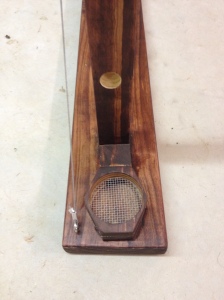
I added an additional 2×4 across the back of the frame for support and used stranded wire with an adjustable bolt to give even more support when its full of honey. I cut ventilation holes and backed them by stapling and gluing #8 hardware cloth so the bees can’t used them as and exit into my house!
To mount the hive I used gate hinges attached to the back of the hive and to a stud in my office. For an exit I used liquid nails to attach a 1 1/4″ fitting in to hole in the base. Then you can buy sump pump tubing at most big box hardware stores for less than $1 per ft. I then took a piece of 1×6 cedar fence plank and cut it down to the correct length to fit into my window slot. I used a hole saw to cut a 1 1/4″ hole in the plank and feed the tube through it for an exit. Here are some more pictures to see how it mounts and the tube exit works.
To attach the glass to the hive I’ll use mirror clips. These clips will hold the glass flush against the frame of the hive. Then when I need to open up the hive I can lift it off the hinges, take it outside, take the 2 mirror clips off the top and slide the glass out. You can get mirror clips at most hardware stores. I tried hobby and hardware stores for buying glass or plastic to use for the facing, but it was going to cost way too much. I finally tried my local auto glass store and was able to get it for $45 total! Total cost breakdown is below
Wood – Free (scrap)
Hinges – $25
Glass – $45
Mirror Clips – $8
Hose – $2
Hose fittings – $5
Total – $85
Dropping $80+ on something isn’t what I would call cheap, but when you compare how much you’ll pay for a hive similar to this it’s extremely reasonable. Here are pictures with the bees in and the glass on. See if you can spot the queen in the first pic.
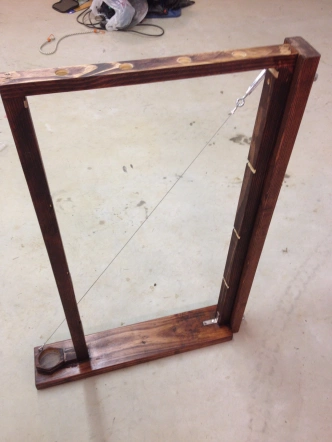
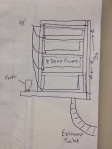
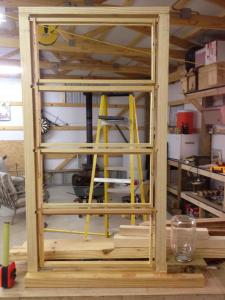



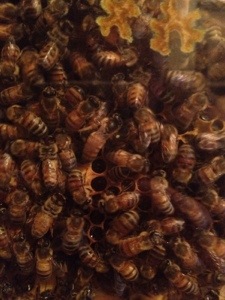
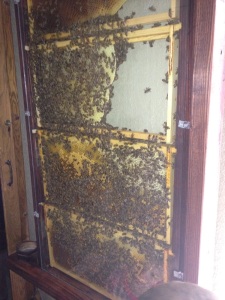
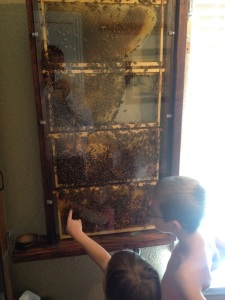
Really beautiful. I’m interested to start a small scale beehive and came across your blog. Keep it up. Your children are so blessed to be able to view this magnificent creatures up close. God bless.
How does this work for winter? My 10 year old it the beekeep of the family and we have one hive that the kids’ beekeeping club helped us establish. It overwintered ok in our more-harsh-than-usual winter last year, but wouldn’t the warmer temperature of them being inside change the way you would need to do things to care for them (even in our relatively cold house)?
They do just fine in the winter. I keep that room around 65-70 degrees. They will ball up just like they would in a large hive. You just have to make sure you feed them since they only have 4 framed they can’t store up reserves for winter.
Question,
Does the smaller hive result in swarming more often? How do you control that with an environment that you cannot change the size of?
It’s not too bad, but really the observation hive is all about learning more about bees. I’m not worried about how much honey they make, I’ll just feed them if I need to. I actually kind of want them to swarm so I can learn to recognize the signs of a hive that is preparing to swarm. That helps me become a better bee keeper and mange my hives that I’m using for honey production more efficiently.
This may seem like a weird question..but how does the bee syrup stay in the mason jar? New to bees..am I missing something?
Sorry, I missed this comment! The answer to your questions is vacuum. If you take a mason jar and poke small holes in the lid and then fill it will sugar water, when you flip it over a small amount will spill out, but with no way for air to get in a vacuum will be created and the liquid will suspend in the mason jar. The bees then stick their “tongues” in and suck it out of the jar.
Hi I have been thinking of making an observation hive very similar to the one you made. My question is, are you able to get the glass off when you remove the clips as you had planned or do the bees glue it all together and make that difficult without breaking the glass?
I actually had a die-out on mine due to lack food. I got busy with life and forgot to feed them and thought they would do fine on their own…wrong. With only 4 frames, they need feeding at least monthly. Anyway, I had no issues removing the glass. As long as their are no gaps, they won’t try to fill them. So make sure your glass is flush against the wood and you should be fine.
Cool idea but there’s no space for a healthy colony on just four deep frames. A brood box on its own has ten and the bees will need all of them, plus at least ten extra smaller frames, filled with honey to survive even a mild winter.
I wonder if it would be a better idea to have an external hive attached to this observation hive – so that the four frames inside would become more of an overflow than the full set-up.
Observation hives aren’t designed for honey production. They are for beekeeper observation only. Many natural hives in hollow trees are smaller than 4 deeps, but they spit out swarms all the time, which is a good thing for an observation hive since it allows the beekeeper to learn predictors of when a hive is about to swarm. You will need to feed the observation hive to keep it going, it won’t be able to “thrive” with stores alone due to the limited size, but it can make it through the winter if you continue to feed them.
Do you think it would harm the bees to build a portable observation hive? By this I mean I would remove a couple of frames from my hive and place them in for observation at my daughter’s for a few hours then return the frames to the main hive. I plan to have only screen holes for air and no open enhances to prevent escape and stings to the kids.
I’ve heard of people doing that. It should be fine if you don’t keep them away from the colony for too long. Otherwise they will start trying to raise a new queen.
I’m just getting started with bees and live in a neighborhood, so I don’t want to huge hive…if I fed them, would I be able to get honey off an observation hive? We’re not wanting to do anything huge, but we’re looking to pollinate our gardens and enjoy some honey just for our immediate family. I’ll have no problem keeping up with feeding, but want to make sure I’ll be able to take some honey. Thoughts?
Sorry, but observation hives aren’t designed for honey production. Really, a hive is a hive no matter the size. I wouldn’t hesitate to go ahead and get a full size hive to start with. An observation hive requires more work and beekeeping “skill” so it wouldn’t be good to start with.
can you build me one?!!!!! I will pay you .
if you can I will buy the glass because it might break if you ship it
Sorry, live is too busy right now. I’m sure if you show this to anyone with any woodworking equipment they could build it. It is very simple.
Hello. Thanks for sharing. This is exactly what I’d like to build (or have my wood working buddy build :-)). Do you still have this hive active? If you were staring over, is there anything you’d do different? How often do you open the hive?
Thanks again or sharing.
I had a die out due to lack of food. I learned a lesson that you can’t skip a couple feedings with an observation hive. They need to be feed at least every 2 or 3 weeks. The only thing I would do differently is to use mediums instead of deeps.
Why mediums? Are you moving to all medium frames? If so, for the reasons Michael Bush recommends on http://www.bushfarms.com/beesnewbees.htm?
Thanks.
Yes, I went all mediums for a lot of the Michael Bush reasons. The main one being, that I could buy medium frames in bulk to save money and then use them on everything.
How did you start it? Split from another hive?
Yes, it was a split from another hive. It was really cool getting to seem them raise a queen!
Do they mind all the light? In a traditional hive it is dark.
I keep a black cloth dropped over them and only remove it when I’m wanting to “observe” them for a little while. they don’t seem to mind when the cloth is removed, they seem to go about business as usual, but keeping the cloth on them is a good idea.
I found this project fascinating and plan to do a modified version of this sometime soon.
I think my biggest question is how you get the bees inside in the first place? Do you dump them in like a bee box and then put on the glass?
I really like this design and plan to make a modified version soon.
My question is how do you get the bees into the observation hive?
I take the front glass off and pull a split from another hive, put the glass back on and then take it in the house. I make sure to leave the queen back in the original hive. That why I get to watch the observation hive make a new queen. Be sure to get frames with plenty of eggs and brood, and feed them all the 1:1 sugar water they will take.
We sell our honey in a small store that does a lot of education. They are asking us if we would put in an observation hive. The only way we could make it work for the entrance is to have a pipe go straight up through the roof of the store. We don’t have a place in the store to go through a side wall. Do you think the bees would be ok with going straight up / down to get in and out of the hive and also do you think they would be ok traveling 7 feet in the entrance pipe?
I don’t think it would be an issue. You’ll want to make sure to put and elbow at the top so that the entrance faces to the side or straight down that way rain and can’t down the pipe. The 7 feet shouldn’t be an issue.
Did you have any issues with ventilation? Mr Bush often talks about working hard to make sure the ventilation is correct. I didn’t see any extra holes so, I’m not sure if I missed them. Thanks for sharing!
No problems with ventilation. If you look close at the very first picture of the article you should be able to see the 4 vent holes across the top. Those have #8 hardware cloth attached to inside so the bee’s can’t get out. I keep masking tape over a couple of them on the outside. I planned to remove the tape if I saw any condensation build up during the humid months of the summer, but I never did so the tape stayed on.
Thank you so much! After your initial die out, are you running bees in there again? What would you do different if you had to do it again? Thanks again for share this great idea!
No bees in there right now. I started coaching HS football again and my time during the spring and summer is limited and I haven’t had time to take it out and “re-stock” it. I really want to get it going again. The only things I would do different is use medium frames (I’m all mediums now for all my hives) and feed, feed, feed!
Pingback: All 3 hives have sugar on top – Schmidt Family Beekeeping